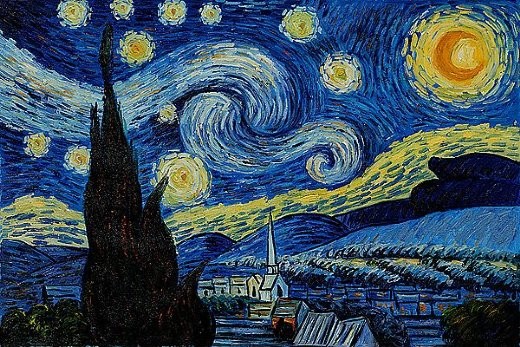
The Starry Night by Vincent van Gogh
Vincent van Gogh depicted a view of the blue-orange night sky on 73.7 x 92.1 centimeters. Tonguing cypress trees border the field of view on the left. In the center, you can see the village of Saint-Rémy with a striking and pointed steeple, wheat fields, olive grove. The houses are illuminated, which Vincent van Gogh liked to add as a sign of life. On the right, the horizon rises to the Alpilles mountain range. About two-thirds of the picture surface is taken up by the night sky. Eleven stars and a crescent-shaped moon, with cosmic energy depicted in the form of waves in between in the center of the picture, complete the Dutchman’s extraordinary invention of the picture.
The composition is bold and complex, although Van Gogh may have worked without a signature. The dark green cypresses on the right were the first to be executed by Vincent van Gogh and were already dry when he painted the other parts of the picture. It is a complement to the starry night seen, as is the towering church tower, which turns the southern French into a Dutch village. Cypresses looked like Egyptian obelisks and their deep, dark colors “like a black spot in a sunny landscape”.
Vincent van Gogh created the painting “The Starry Night” on June 18, 1899, one of his most famous works. The Dutchman was a great lover of nature. As a teenager, he roamed fields and polders and admired the beauty of the heavenly play of colors. After his traumatic experience with Paul Gauguin in the “Atelier of the South” and his subsequent illness at the end of 1888, he found peace and comfort in the nocturnal landscape (→ Vincent van Gogh: Paul Gauguin in Arles). The work has been owned by the Museum of Modern Art in New York since 1941.

The Persistence of Memory by Salvador Dali
The picture was made in 1931. It is painted with oil paints on a canvas that is 24 x 33 cm, so it is a relatively small painting.
Strange things are gathered in a puzzling constellation in the picture. A wide landscape can be seen. The ground is relatively dark and only becomes lighter in the distance and to the right, where a rugged mountain range rises.
A brown block slides into the picture from the left. A little further back, a kind of board protrudes into the picture from the left edge of the picture. A single branch protrudes from the hollow tree trunk, above which a silver clock with a light blue face hangs. Another clock is on the block. It is gold with a blue dial with a fly on it. The hands point just before seven. On the block is a second clock that shimmers red and lies on the face.
Ants crawl on the housing and orient themselves towards the center. In the middle lies an amorphous structure in whitish tones. In the narrow end the structure is lost in the darkness of the ground. It has a closed eyelid with very long, fine eyelashes, above which you can see brows. The nose is too small compared to the eyes. Under the nose there is a somewhat reddish structure that could represent a tongue. There is also a soft, silvery clock on the object.
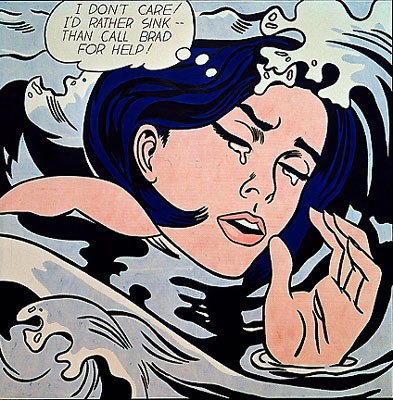
Drowning Girl by Roy Lichtenstein
Drowning Girl (also known as Secret Hearts or I Don’t Care! I would rather go under) is a painting by Roy Lichtenstein made of oil and synthetic polymer paint on canvas from 1963. The painting is one of Lichtenstein’s most important works, perhaps on the level of his celebrated Diptych Whaam! Drowning Girl, one of the most representative paintings of the Pop Art movement, was acquired by the Museum of Modern Art in 1971.
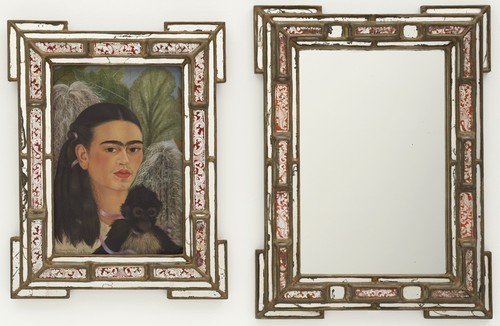
Fulang-Chang and I by Frida Kahlo
Of Kahlo’s around 150 paintings, at least a third show her pets. Kahlo saw her animals as an extension of her own being and she had a few of them. In addition to a parrot, a fawn, an eagle, some parakeets, macaws, chickens, sparrows, and the Mexican Xoloitzcuintli (an old hairless breed of dog), she also owned spider monkeys, which she kept in the garden of her house, the Casa Azul.
Art historians believe that Kahlo saw the monkeys as symbols for the children she could never have. She particularly liked the strange appearance of the monkeys with their long, spindle-shaped legs, because it reminded her of her own right leg. Because of polio, it was thinner than the left one and later even had to be amputated.
Fulang Chang and I is Kahlo’s first self-portrait that features the spider monkeys, but many more would follow. In Mexican mythology, the monkey is a symbol of lust. In Kahlo’s paintings they are depicted as delicate and gentle, sometimes with their arms around Kahlo’s neck. She wears a hairband that winds around the monkey, just as if the two were connected. Kahlo was very proud of this picture and gave it to her good friend Mary Schapiro Sklar as a present, along with a mirror in a similar frame. She recommended that Sklar hang the picture and the mirror next to each other so that Sklar could always see herself next to Frida.
The Water Lily Pond by Claude Monet
The art of Claude Monet (1840-1926) is the epitome of impressionism. During his long life as a painter, he was tirelessly looking for ways to depict the changeability of light and colors in many atmospheric variants and at different times of the day.
Born in Paris, he grew up on the Normandy coast, in Le Havre, where his father ran a small grocery store. Monet made his first artistic attempts in the field of caricature but then turned to outdoor painting. Light pastel tones found their way onto his canvases. His pictures were repeatedly rejected by the official Paris Salon, but Monet and his friends Auguste Renoir and Alfred Sisley were not discouraged. On their joint exposition to Fontainebleau, they created wonderfully fresh pictures in the great outdoors, which left the strict academic rules behind them.
But soon serious financial crises hit Monet and his pregnant lover Camille. During the Franco-German War, Monet and the young family fled to London. After the war, they settled in Argenteuil. This small place outside Paris, picturesquely situated on the Seine, then became a magnet for a number of Impressionist painters: Edouard Manet, Gustave Caillebotte, but also Camille Pissarro, Auguste Renoir, and Alfred Sisley met there to get their fresh impressions To ban canvas. In the group’s first independent exhibition, a picture by Monet “Impression. Sunrise “of the art direction to their name.
The Death of Socrates by Jacques-Louis David
In the middle of the 18th century, several styles dominated European art taste. The Rococo was taking shape in France, while Baroque art had established itself across Europe. While these two popular art eras were characterized by a tendency towards extravagance, not all artists of the 18th century shared this mood. Classicist painters such as Jacques-Louis David turned against these forms of design, as his subtle masterpiece The Death of Socrates shows.
The death of Socrates is one of the most famous works of art from the classical era. In the 1780s, the French artist Jacques-Louis David began realizing works that showed an interest in classical motifs and strict aesthetics.
He completed the painting The Death of Socrates at the height of this creative phase in 1787 and handed the work over to the Paris Salon that same year.
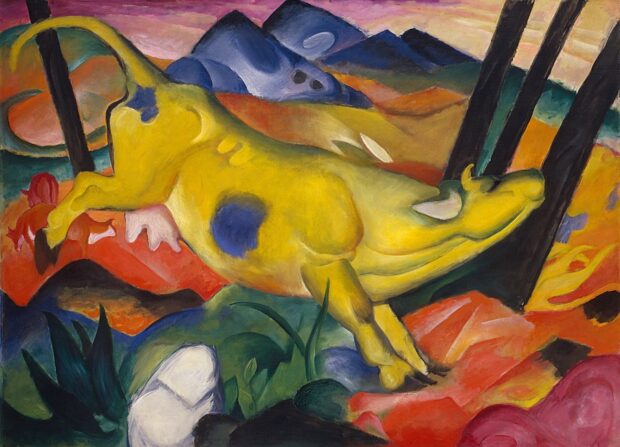
The Yellow Cow by Franz Marc
In 1912 Franz Marc and Wassily Kandinsky published the almanac “Der Blaue Reiter”. It has long been considered the founding manifesto of modern art. But there were quite different views: Franz Marc felt Impressionism more like a Romance depiction, because as a mystic he was inclined to contemplate Expressionism. Marc and Kandinsky were in agreement, however, in their attitude towards their art: Neither trends, social views, or financial aspects should be allowed to divert the artist from his convictions.
Franz Moritz Wilhelm Marc (born February 8, 1880, in Munich – died March 4, 1916, in the trench warfare near Verdun, France) was significantly influenced by Gauguin and van Gogh. He was friends with August Macke, through whom he got in touch with Wassily Kandinsky, Alfred Kubin, and Gabriele Münter. Together they founded the expressionist artists’ association “Der Blaue Reiter” in 1911. From 1910 to 1914 he used stylistic elements of Cubism, Fauvism, Futurism, and Orphism because he was looking for his own expression to represent the spiritual in art.
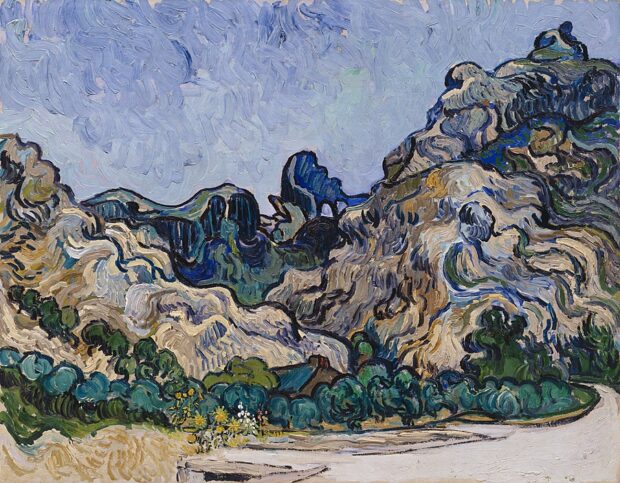
Mountains at Saint-Rémy
“I feel especially old when I think that most people I know think I’m a failure and that this may be true if things don’t change for the better. And when I admit that this can happen, I feel my failure so vividly and it’s painful that this completely suppresses me and I’m losing all desire to live as if I had actually already suffered a similar fate. I learned for the future and feel the energy and strength in myself for another thirty years, if, of course, I live for that long. ” (Vincent Van Gogh).

Children Meeting by Elizabeth Murray
Elizabeth Murray had a huge vocabulary that could be really interesting to use with the lines, shapes, and colors associated with comics, as well as the simplicity of form derived from reductive abstraction. Meeting the Children was created at a time when Murray was solidifying her visual language.

A Ride for Liberty — The Fugitive Slaves
The painting depicts a black family rushing towards freedom on their horse. The inspiration for the artist Johnson was a real situation that he saw during his participation in the civil war in Manassas.
Like us on Facebook for more stories like this: